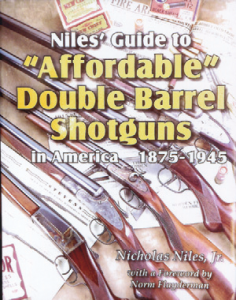Review by Larry S. Sterett | Contributing Editor 
NILES’ GUIDE TO “AFFORDABLE” DOUBLE BARREL SHOTGUNS IN AMERICA 1875–1945, by Nicholas Niles, Jr. ©2012. Published by Mowbray Publishing, 54 East School Street, Dept. TGM, Woonsocket, RI 02895. Price: $69.95, plus $4.50 shipping. Available through most bookstores, or direct by phone: 800- 999–4697 in USA.
This 512-page hardbound tome is the result of the author collecting some 800 “affordable” double barrel shotguns before beginning assembling this wonderful gem. The result of such a collection adds authority; the man knows his subject, or as the old phrase goes, he’s “been there and done that.”
In addition to 14 chapters, five appendices, a bibliography, and an index, this 5¼-pound volume features a list of the five “affordables” shown on the cover—they range from a 1909 Aubrey produced for sale by Sears, Roebuck & Co., to a Model 530 Stevens from 1936—an explanation of frames with diagrams and nomenclature, a listing of the 373 illustrations in this volume, lists of the trade catalogs and stock certificates reproduced within the book, a Foreword by the late Norm Flayderman, dedication and acknowledgement, and a five-page outstanding introduction. Following the final chapter, but preceding the bibliography is a page of abbreviations, five pages of definitions, plus tables of bore dimensions, chamber lengths, shotshell lengths, type faces, illustrations of stock certificates, and shotgun barrel steels and barrel making methods.
The first four chapters are devoted to makers and marketers of the various “affordable” shotguns during the period discussed, an overview, important Belgian imports, and brand management and marketing. Beginning with Chapter 5 and continuing through Chapter 10, the various known arms groups which produced or marketed shotguns produced for them are discussed. Among these are H&D Folsom, Montgomery Ward, Sears, Roebuck, Hopkins & Allen, Iver Johnson, and Ithaca.
Chapter 11 features a comprehensive listing of the many known “affordable” brands from 1875 to 1945, beginning with the A & F Knockabout and ending with Angelo Zoli. The type of action, the maker (when known), and the marketer (when known) are also listed.
(Some post- 1945 brands are also listed, and most of these are easily spotted, as the firms did not exist in 1945, such as the Navy Arms Co. of Val Forgett, and Sturm, Ruger & Co.. As an example, the Pioneer Arms Company side/side was a hammer sidelock design produced by Pieper in Liege, Belgium, and marketed by Schoverling, Daly & Gales in New York City. A hammerless boxlock side/side with the same name— Pioneer Arms Company—was produced by Stevens and marketed by Kruse Hardware Company in Cincinnati, OH.
At least a dozen shotgun models bore the Richards name, with four being W. Richards, one being M. Richards, one W&H, and one H. Richards, etc. These were not manufactured by the Westley Richards firm in Birmingham, England, as an unsuspecting buyer might think. Most were produced in Belgium, and at least one model here in the US by the H&D Folsom Arms Co. in the late 19th century.
Chapters 12 and 13 are devoted to “affordable” shotshells and collectibles, including the shotguns. Estimated values are provided for a number of the scarcer or unique models. Comments are also provided regarding those models which were produced in such large quantities they may not become scarce for decades. As an example, Iver Johnson shotguns are often thought of as being good, serviceable products, but not necessarily the top quality, but some of their side/side models today, such as the smallbore “Skeet-Er” model, command top prices in good condition.
Except for the photos of various old catalogs, all the illustrations in this gem are in color, and many are close-up views to emphasize detail. (The old catalog pages are woodcuts or engravings of the various shotguns, and were originally printed in black and white; in this volume the catalog cuts are printed on a light colored background, and not on a white background.) Coupled with the other information in this book, the photographs are valuable for helping in the identification of a specific shotgun.
This is an excellent reference volume for any arms collector, museum curator, dealer, or even a gunsmith who may be called on to repair Grandpa’s old side/ side. It may not contain every brand of two barrel shotguns—side/side or over/ under—ever manufactured, but there can’t be many that have been missed.
(This reviewer knows of two shotguns— one side/side and one over/under—he couldn’t find listed, or at least under the names on the sideplates.) It’s the most comprehensive book of its type available on the market today.



